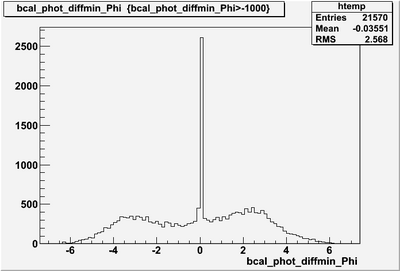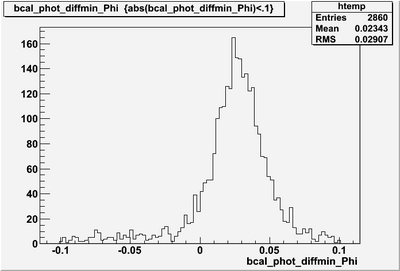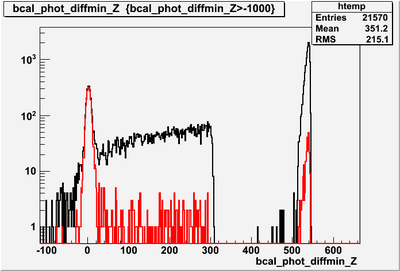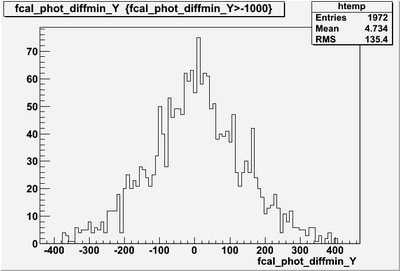Reconstruction, June 16, 2009
From GlueXWiki
Time: 11:00 EST/10:00 CST
- See GlueX Communications for detailed instructions
- ESNET Number 8542553
Contents
Reconstruction To Do List
- Generation
-
 Use genr8 for a2 production
Use genr8 for a2 production -
 Skim off (hd_filter) the wanted events by cutting on the total neutral energy (> 6 GeV) but record the total number of events before skimming. The resulting MC data set will be stored for general use.
Skim off (hd_filter) the wanted events by cutting on the total neutral energy (> 6 GeV) but record the total number of events before skimming. The resulting MC data set will be stored for general use. -
 Use Pythia for background generation after removing a2 → η π0 from the MC data stream as well as events with total neutral energy <= 6GeV.
Use Pythia for background generation after removing a2 → η π0 from the MC data stream as well as events with total neutral energy <= 6GeV. -
 Use a2 charge exchange production xsection vs pythia total xsection to estimate number of signal and noise events
Use a2 charge exchange production xsection vs pythia total xsection to estimate number of signal and noise events
-
- Analysis
-
 After pruning the Pythia events, check the generated vs. reconstructed energy in a plot.
After pruning the Pythia events, check the generated vs. reconstructed energy in a plot. -
 Look at the a2 mass peak - adjust cuts on the eta and pi0 masses then look at the effect on the different angular distributions (i.e. Gottfried-Jackson angles, etc.)
Look at the a2 mass peak - adjust cuts on the eta and pi0 masses then look at the effect on the different angular distributions (i.e. Gottfried-Jackson angles, etc.) -
 look at difference between reconstructed and generated z position for less than 65 cm
look at difference between reconstructed and generated z position for less than 65 cm -
 look at single photon reconstruction efficiencies
look at single photon reconstruction efficiencies -
 adjust the error matrix for the BCAL (look in PID/DPhoton_factory.cc)
adjust the error matrix for the BCAL (look in PID/DPhoton_factory.cc)
-
-
 Gather all relevant DocDB documents and cross section publications at one spot on the Wiki.
Gather all relevant DocDB documents and cross section publications at one spot on the Wiki.
Documents to Review
Tentative Agenda
- Swimming protons
- Discussion on Analysis
swimming particles
- Step 1: use the HDParSim plugin to handle the charged particles (smearing, acceptance, etc.) eg. "fcalTree2 --plugin=hdparsim -PDEFTAG:DParticle=HDParSim -PTHREAD_TIMEOUT=60 -PPRINT_PLUGIN_PATHS=1 hdgeant_01.hddm"
- Step 2: HOWTO Project a charged track to a radius or plane I've first swum the particles to the radius of the BCAL. Any protons that fail to do this are then swum to the FCAL plane.
- Step 3: Compare swum positions to DPhoton shower positions.
protons in the BCAL
- There are 5000 thrown events (γp -> ηπ0p -> 4γp) therefore containing 5000 protons with an average of 4-5 showers produced in the GlueX calorimeters (shown below).
- Looking at the difference between the azimuthal angle at the BCAL of the swum proton and the reconstructed showers (DPhoton) there is a definite peak at Δφ = 0. I've taken the swum position and looped over N DPhoton positions and kept the N differences. This produces 21,570 possible combinations.
- Making a cut on Δφ < 0.1 radian (~5.7 degrees) there are 2860 surviving showers (~57%). Also, HDParsim only returns 4214 (~84%) of the initial 5000 thrown protons.
- Looking at the difference between the final proton Z position and the possible DPhoton showers, there is a clear peak around zero (shown in Red below) after making the cut on Δφ < 0.1 radians.
protons in the FCAL
- Taking only the protons that didn't reach the BCAL and swimming them to the FCAL plane, I repeated the same comparison




